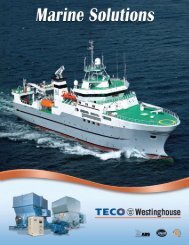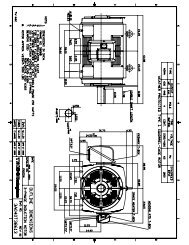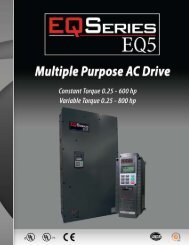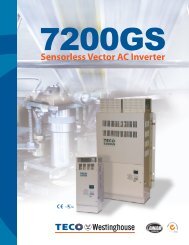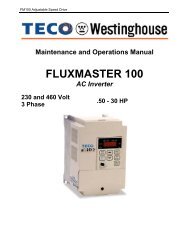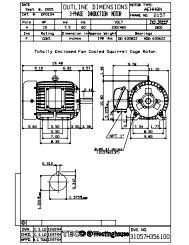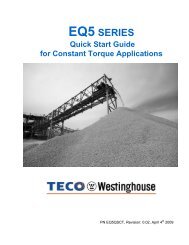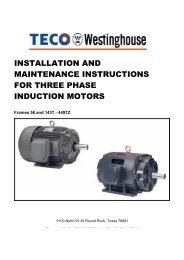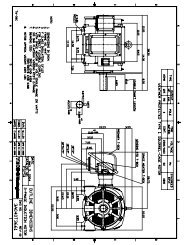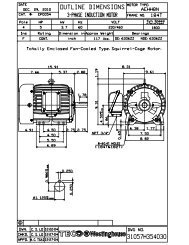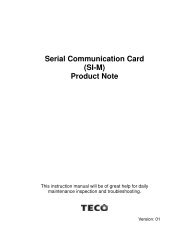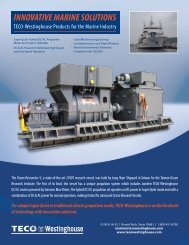EQ7 Series Instruction Manual - TECO-Westinghouse Motor Company
EQ7 Series Instruction Manual - TECO-Westinghouse Motor Company
EQ7 Series Instruction Manual - TECO-Westinghouse Motor Company
Create successful ePaper yourself
Turn your PDF publications into a flip-book with our unique Google optimized e-Paper software.
10.4 If an Alarm Code Appears on the LED Monitor<br />
[ 1 ] Instantaneous overcurrent<br />
Problem The inverter momentary output current exceeded the overcurrent level.<br />
Overcurrent occurred during acceleration.<br />
Overcurrent occurred during deceleration.<br />
Overcurrent occurred during running at a constant speed.<br />
Possible Causes<br />
(1) The inverter output lines were<br />
short-circuited.<br />
(2) Ground faults have occurred at<br />
the inverter output lines.<br />
What to Check and Suggested Measures<br />
Disconnect the wiring from the inverter output terminals ([U], [V] and [W]) and<br />
measure the interphase resistance of the motor wiring. Check if the resistance<br />
is too low.<br />
Remove the short-circuited part (including replacement of the wires, relay<br />
terminals and motor).<br />
Disconnect the wiring from the output terminals ([U], [V] and [W]) and perform<br />
a Megger test.<br />
Remove the grounded parts (including replacement of the wires, relay<br />
terminals and motor).<br />
(3) Overload. Measure the motor current with a measuring device to trace the current trend.<br />
Then, use this data to judge if the trend is over the calculated load value for<br />
your system design.<br />
If the load is too heavy, reduce it or increase the inverter capacity.<br />
(4) Excessive torque boost<br />
specified.<br />
(when F37* = 0, 1, 3, or 4)<br />
(5) The acceleration/ deceleration<br />
time was too short.<br />
Trace the current trend and check if there are any sudden changes in the<br />
current.<br />
If there are any sudden changes, make the load fluctuation smaller or<br />
increase the inverter capacity.<br />
Enable instantaneous overcurrent limiting (H12 = 1).<br />
Check whether decreasing the torque boost (F09*) decreases the output<br />
current but does not stall the motor.<br />
If no stall occurs, decrease the torque boost (F09*).<br />
Check that the motor generates enough torque required during<br />
acceleration/deceleration. That torque is calculated from the moment of<br />
inertia for the load and the acceleration/deceleration time.<br />
Increase the acceleration/deceleration time (F07, F08, E10 through E15,<br />
and H56).<br />
Enable the current limiter (F43) and torque limiter (F40, F41, E16, and<br />
E17).<br />
Increase the inverter capacity.<br />
(6) Malfunction caused by noise. Check if noise control measures are appropriate (e.g., correct grounding and<br />
routing of control and main circuit wires).<br />
Implement noise control measures. For details, refer to the <strong>EQ7</strong> User's<br />
<strong>Manual</strong>, "Appendix A."<br />
Enable the Auto-reset (H04).<br />
Connect a surge absorber to magnetic contactor's coils or other solenoids<br />
(if any) causing noise.<br />
[ 2 ] Ground fault<br />
Problem A ground fault path exists from the output terminal of the inverter.<br />
Possible Causes<br />
(1) Inverter output terminal(s)<br />
grounded (ground fault).<br />
What to Check and Suggested Measures<br />
Disconnect the wiring from the output terminals ([U], [V], and [W]) and perform a<br />
Megger test.<br />
Remove the grounded parts (including replacement of the wires, relay<br />
terminals and motor).<br />
10-12



